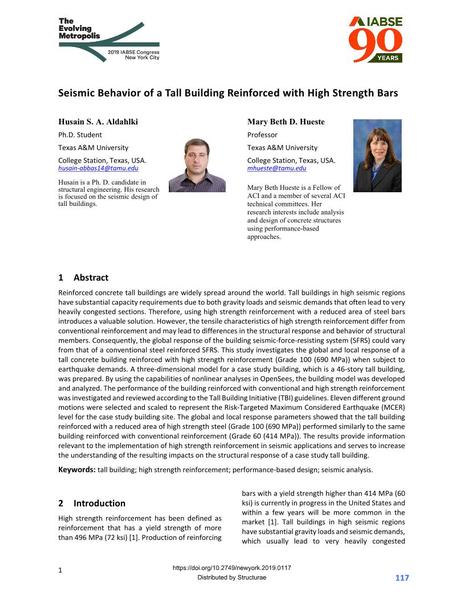Seismic Behavior of a Tall Building Reinforced with High Strength Bars

|
|
|||||||||||
Bibliografische Angaben
| Autor(en): |
Husain S. A. Aldahlki
(Texas A&M University)
Mary Beth Hueste (Texas A&M University) |
||||
|---|---|---|---|---|---|
| Medium: | Tagungsbeitrag | ||||
| Sprache(n): | Englisch | ||||
| Tagung: | IABSE Congress: The Evolving Metropolis, New York, NY, USA, 4-6 September 2019 | ||||
| Veröffentlicht in: | The Evolving Metropolis | ||||
|
|||||
| Seite(n): | 117-122 | ||||
| Anzahl der Seiten (im PDF): | 6 | ||||
| DOI: | 10.2749/newyork.2019.0117 | ||||
| Abstrakt: |
Reinforced concrete tall buildings are widely spread around the world. Tall buildings in high seismic regions have substantial capacity requirements due to both gravity loads and seismic demands that often lead to very heavily congested sections. Therefore, using high strength reinforcement with a reduced area of steel bars introduces a valuable solution. However, the tensile characteristics of high strength reinforcement differ from conventional reinforcement and may lead to differences in the structural response and behavior of structural members. Consequently, the global response of the building seismic-force-resisting system (SFRS) could vary from that of a conventional steel reinforced SFRS. This study investigates the global and local response of a tall concrete building reinforced with high strength reinforcement (Grade 100 (690 MPa)) when subject to earthquake demands. A three-dimensional model for a case study building, which is a 46-story tall building, was prepared. By using the capabilities of nonlinear analyses in OpenSees, the building model was developed and analyzed. The performance of the building reinforced with conventional and high strength reinforcement was investigated and reviewed according to the Tall Building Initiative (TBI) guidelines. Eleven different ground motions were selected and scaled to represent the Risk-Targeted Maximum Considered Earthquake (MCER) level for the case study building site. The global and local response parameters showed that the tall building reinforced with a reduced area of high strength steel (Grade 100 (690 MPa)) performed similarly to the same building reinforced with conventional reinforcement (Grade 60 (414 MPa)). The results provide information relevant to the implementation of high strength reinforcement in seismic applications and serves to increase the understanding of the resulting impacts on the structural response of a case study tall building. |
||||
